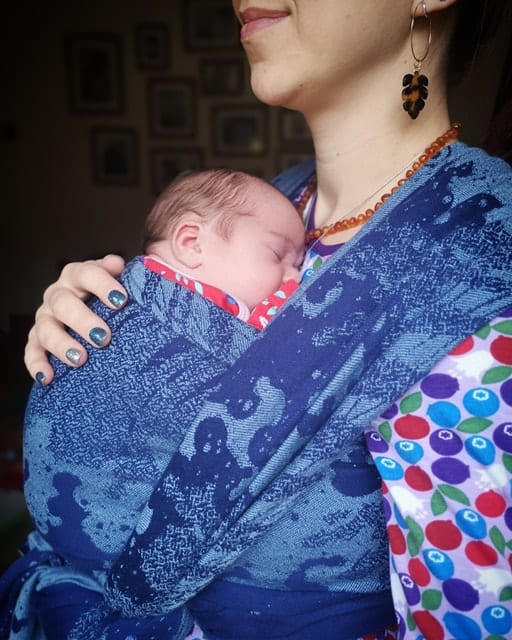Using Woven Wraps
The Physical and Emotional Benefits of Babywearing: Evidence Based Studies
Ask any baby wearer about the benefits of slings and they’ll happily tell you how the were an essential part of the parenting tool kit- that they couldn’t have imagined coping without them! Each of us has our personal anecdotes of situations that they made easier, or even possible at all. We can tell you of how they they helped refluxy babies to settle to sleep, let us get out and about where prams couldn’t reach, freed our hands so that we could look after older children, helped us to feel connected with our little ones- the list is huge!
It is important to remember that these benefits have been instinctively known and passed down for thousands of years- baby wearing is not a new invention or discovery, although for many of us in Western society it is a modern reintroduction as our baby wearing lineage has been broken or lost.
All the historical and anecdotal evidence overwhelmingly demonstrates that carrying our children in slings is a great thing to do, but did you know that people have taken it one step further and actually run scientific, quantifiable studies into the benefits of baby wearing for both child and caregiver?
Here is an overview of the science behind baby wearing.
This evidence was compiled by wetheparents.org, and the text uses the term ‘mother’ frequently. We believe that the words ‘father’ ‘parent’ or ‘ primary caregiver’ would also fit interchangeably within the scope of the evidence and be more inclusive of the breadth of individuals with a key relationship to the infant.
Some of this evidence is directly measured benefit from baby carrying studies. Some is inferred benefit from very closely related studies, and some relates to ‘Kangaroo care’ benefits. Kanagroo care is typically characterised by skin to skin contact and babywearing, most often with pre-term infants.
1. Promotes Secure Mother Baby Attachment
Key Study/Paper
Anisfield E et.al. (1990). ” Does infant carrying promote attachment? An experimental study of the effects of increased physical contact on the development of attachment” Child Development 61(5):1617-27
Findings
The high level of maternal touch associated with babywearing is related to enhanced mother-infant bonding and secure attachment.
2. Baby Cries Less
Key Study/Paper
Hunziker UA, Barr RG (1986). “Increased carrying reduces infant crying: a randomised controlled trial.” Pediatrics 77(5), 641-8
Findings
Babywearing for three hours a day reduced infant crying by upto 54 percent.
3. Aids Baby’s Healthy Physical Development
Key Study/Paper
Field T et al (2010) “Preterm Infant Massage Therapy Research. A review” Infant behaviour and development 33(2) 115-124
Findings
Tactile stimulation in the form of massage or passive movement of limbs lead to weight gain and an increase in bone density.

4. Makes Mother More Responsive To Baby
Key Study/Paper
Anisfield E et.al. (1990). ” Does infant carrying promote attachment? An experimental study of the effects of increased physical contact on the development of attachment” Child Development 61(5):1617-27
Findings
Mothers who wore their babies in a soft carrier were more responsive to their infants, indicating that the close physical contact promoted nurturing behaviour.
5. Reduces Reflux Symptoms
Key Study/Paper
Jung WJ et al, (2012) “The efficacy of the upright position on gastro-esophageal reflux and reflux- related respiratory symptoms in infants with Chronic respiratory symptoms.” Allergy Asthma & Immunology Research,4,1:17-23
Findings
Infants set in an upright position (as opposed to reclined on their backs) had fewer ‘reflux related symptoms’, ie, less spitting-up, vomiting, coughing or breathing problems.
6. Helps Depressed Mothers To Nurture Their Babies
Key Study/Paper
Pelaez-Nogueras M et al (1996). “Depressed mothers’ touching increases infants’ positive affect and attention in still-face interactions” Child Development, 67(4):1780-92
Findings
Babies responded positively to touch even when their depressed mothers remain quiet with a ‘still face’. Touch stimulation may compensate for a depressed mothers’ flat vocal and facial expression.
7. Improves Breastfeeding Rates
Key Study/Paper
Pisacane A et al (2012). “Use of baby carriers to increase breastfeeding duration among term infants: the effects of an educational intervention in Italy.” Acta Paediatrica, 101 (10):3434-8
Findings
Mothers who used baby carriers for at least 1 hr per day during the first months of life had significantly higher breastfeeding rates at 3 and 5 months.

8. Soothes Baby When Distressed
Key Study/Finding
Byrne JM, Horowitz FD (1981): “Rocking as a soothing intervention: The influence of direction and type of movement” Infant Behaviour and Development, 4:207-218
Findings
Distressed infants between 1-3 days old were most effectively soothed when held and rocked with a continuous motion.
9. Encourages Wellbeing and Relaxation in Both Mother and Baby
Key Study/Paper
Uynas-Moberg K. (1997) “Oxytocin linked antistress effects- the relaxation and growth response.” ActaPhysiol Scan Suppl 640: 38-42
Findings
Warmth and touch stimulate oxytocin release which is known to induce anti stress- like effects such as reduction of blood pressure and cortisol levels.
